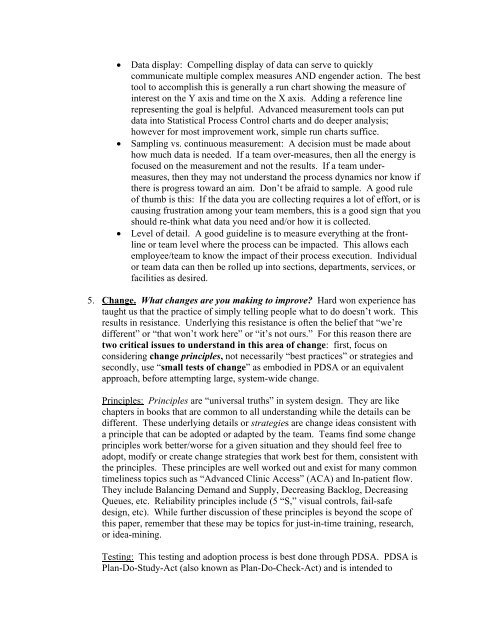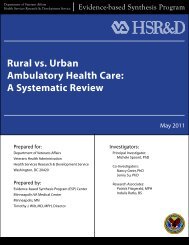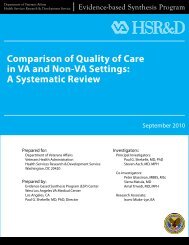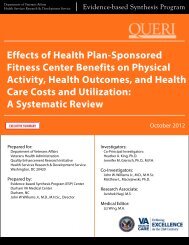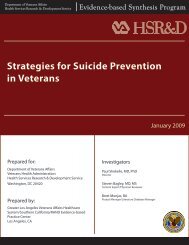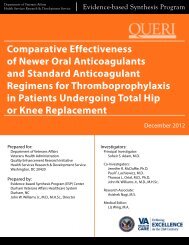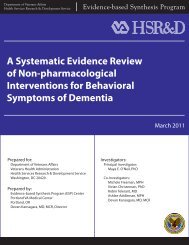VHA Systems Redesign; Transformational change in health care ...
VHA Systems Redesign; Transformational change in health care ...
VHA Systems Redesign; Transformational change in health care ...
Create successful ePaper yourself
Turn your PDF publications into a flip-book with our unique Google optimized e-Paper software.
• Data display: Compell<strong>in</strong>g display of data can serve to quickly<br />
communicate multiple complex measures AND engender action. The best<br />
tool to accomplish this is generally a run chart show<strong>in</strong>g the measure of<br />
<strong>in</strong>terest on the Y axis and time on the X axis. Add<strong>in</strong>g a reference l<strong>in</strong>e<br />
represent<strong>in</strong>g the goal is helpful. Advanced measurement tools can put<br />
data <strong>in</strong>to Statistical Process Control charts and do deeper analysis;<br />
however for most improvement work, simple run charts suffice.<br />
• Sampl<strong>in</strong>g vs. cont<strong>in</strong>uous measurement: A decision must be made about<br />
how much data is needed. If a team over-measures, then all the energy is<br />
focused on the measurement and not the results. If a team undermeasures,<br />
then they may not understand the process dynamics nor know if<br />
there is progress toward an aim. Don’t be afraid to sample. A good rule<br />
of thumb is this: If the data you are collect<strong>in</strong>g requires a lot of effort, or is<br />
caus<strong>in</strong>g frustration among your team members, this is a good sign that you<br />
should re-th<strong>in</strong>k what data you need and/or how it is collected.<br />
• Level of detail. A good guidel<strong>in</strong>e is to measure everyth<strong>in</strong>g at the frontl<strong>in</strong>e<br />
or team level where the process can be impacted. This allows each<br />
employee/team to know the impact of their process execution. Individual<br />
or team data can then be rolled up <strong>in</strong>to sections, departments, services, or<br />
facilities as desired.<br />
5. Change. What <strong>change</strong>s are you mak<strong>in</strong>g to improve? Hard won experience has<br />
taught us that the practice of simply tell<strong>in</strong>g people what to do doesn’t work. This<br />
results <strong>in</strong> resistance. Underly<strong>in</strong>g this resistance is often the belief that “we’re<br />
different” or “that won’t work here” or “it’s not ours.” For this reason there are<br />
two critical issues to understand <strong>in</strong> this area of <strong>change</strong>: first, focus on<br />
consider<strong>in</strong>g <strong>change</strong> pr<strong>in</strong>ciples, not necessarily “best practices” or strategies and<br />
secondly, use “small tests of <strong>change</strong>” as embodied <strong>in</strong> PDSA or an equivalent<br />
approach, before attempt<strong>in</strong>g large, system-wide <strong>change</strong>.<br />
Pr<strong>in</strong>ciples: Pr<strong>in</strong>ciples are “universal truths” <strong>in</strong> system design. They are like<br />
chapters <strong>in</strong> books that are common to all understand<strong>in</strong>g while the details can be<br />
different. These underly<strong>in</strong>g details or strategies are <strong>change</strong> ideas consistent with<br />
a pr<strong>in</strong>ciple that can be adopted or adapted by the team. Teams f<strong>in</strong>d some <strong>change</strong><br />
pr<strong>in</strong>ciples work better/worse for a given situation and they should feel free to<br />
adopt, modify or create <strong>change</strong> strategies that work best for them, consistent with<br />
the pr<strong>in</strong>ciples. These pr<strong>in</strong>ciples are well worked out and exist for many common<br />
timel<strong>in</strong>ess topics such as “Advanced Cl<strong>in</strong>ic Access” (ACA) and In-patient flow.<br />
They <strong>in</strong>clude Balanc<strong>in</strong>g Demand and Supply, Decreas<strong>in</strong>g Backlog, Decreas<strong>in</strong>g<br />
Queues, etc. Reliability pr<strong>in</strong>ciples <strong>in</strong>clude (5 “S,” visual controls, fail-safe<br />
design, etc). While further discussion of these pr<strong>in</strong>ciples is beyond the scope of<br />
this paper, remember that these may be topics for just-<strong>in</strong>-time tra<strong>in</strong><strong>in</strong>g, research,<br />
or idea-m<strong>in</strong><strong>in</strong>g.<br />
Test<strong>in</strong>g: This test<strong>in</strong>g and adoption process is best done through PDSA. PDSA is<br />
Plan-Do-Study-Act (also known as Plan-Do-Check-Act) and is <strong>in</strong>tended to


